Several years ago, I witnessed a particular action from a friend’s dog that startled me. The dog had come into their living room on a lazy afternoon and looked around for a place to lie down, to find the other dogs had already claimed all of the best snoozing spots. He actually got a slightly pained expression, tail dropping and ears twitching back slightly as if hearing a harsh sound – then he immediately turned and trotted into the adjoining room, one with a window overlooking the driveway. With a single sharp bark, he woke the other dogs and sent them into a mad frenzy of barking and scrambling for the window, eager to protect the house against intruders (and likely, to no small extent, competing with the others to show how good they were at it.) But in this chaos, he dashed past them in the opposite direction and claimed the best spot for himself, with what can only be described as a satisfied air.
I was impressed. I’d worked with animals for a long time at this point in my life, which included training dogs for obedience and working with wildlife in rehab, and I had some background in observing behavior. This was a level of thinking that seemed well above normal, actually quite clever for a canine. If you’re familiar with dogs, you’ll know that most times there’s either a dominant one who will claim a favored spot for itself every time, or one might simply crowd another out of a prime snoozing location (our cats do this all the time.) This dog not only imagined a scenario based on a stimulus response, he used deception.
There are plants that, when being attacked by parasitic insects, develop a chemical response that not only repels the insects, it carries on the wind and is detected by other plants of the same species, triggering their own chemical response – the plants produce a ‘group effort’ in repelling damaging attacks. Species of bees and ants, when crushed, emit a chemical that causes others to either avoid the area, or to swarm to it and attack at the point of emanation – this is the cause of the dangerous bee swarms that make it into the news from time to time.
For these latter examples, we generally see this as simply an evolved mechanism, a cause-and-effect apparatus – we don’t believe that plants or bees think about their actions, or plan them, or understand them. It’s just something that worked and was incorporated into the species by preferential selection. In the dog’s case however, we see a level of cognition, of planning an action to invoke an observed response, yet we still can’t imagine the canine to be capable of playing checkers or figuring out how to run the lawnmower, even if we leave the keys in it. Even though the dog recognized and exploited a simple canine trait, that of maintaining territorial boundaries, he probably didn’t fathom how this trait came about or how it differentiated dogs from chickens. With these examples, we can see that behavior may involve a spectrum of neural activity ranging from mere stimulus response to imagining a scenario based on observed patterns, at some point in there crossing into cognition, and then thinking, and eventually intelligence. And we place ourselves, Homo sapiens, at the pinnacle of this pyramid.
Now, this is a justifiable perspective, if we limit ourselves to just species on this planet (not unwarranted,) and if we consider intelligence in terms of abstract thought and the ability to change one’s environment – it should be noted, however, that intelligence does not equate with ability to survive (bacteria thwart this attitude readily) or represent a direction natural selection must be going in. Yet, we still often believe that we have the ability to puzzle out all of the secrets of the universe.
Think about this for a second. In terms of complexity, our minds are not significantly different from those of dogs or chimpanzees, especially when compared to the range of neural networks available throughout the animal kingdom. We live in a tiny thin shell on the outside edge of a rather small planet, an infinitesimal fraction of matter just in our immediate cosmic neighborhood. We have no good idea how long our ability to form abstract thoughts has been around, in the species that led up to us, but it’s safe to say it’s a tiny fraction of the life of the planet, itself only a third as old as the universe, or at least the bits we have managed to figure out so far. The only experience we have with all of this are the physical laws we’ve so far puzzled out, based on what occurs here on Earth or just outside, and nothing but light from the vast remainder, observed at a remote distance. To believe that we will even grasp what occurred 13.7 billion years ago at the supposed start is ego on a stunning scale (one might almost say “universal.”)
Sometimes we’re aware of our limitations, knowing we can see only a narrow spectrum of light or that there remain rules of physics that we haven’t grasped yet – but that “yet” is always in there. Consider that we are organisms evolved to exploit the conditions surrounding us, as much so as a halibut. It’s fairly safe to say that a halibut, even the biggest genius among halibuts, has no concept of space, as in the stuff that contains planets and comets and perhaps a teapot, and if we were to try and explain this concept to halibuts, we’d be hard pressed to be able to communicate it even in analogies. This is, of course, after having surmounted the obstacle of halibut language, or even the likelihood that there isn’t one and we’d have to wrangle out some symbology that works in its place. And then determine what an expression of sudden comprehension looks like on a cubist piscine face…
We even struggle with the attempt to explain color to a person blind from birth, and they speak our language! So it’s no surprise that we often believe there is little chance we’ll understand what a bee is thinking, or if grass feels pain or any analog thereof. Yet when it comes to other pursuits, largely in the realm of physics, we usually approach these from the perspective that all secrets will be revealed in time. We will discover how the universe began; we’re bound to find out how simple chemicals started on the path of combining and replicating in the process we call life; the cure for all human illnesses is waiting to be found, though it’s a race against the eventual practice of downloading minds into machinery and colonizing other planets and reaching other star systems.
The highest probability, however, is that we will never know most of these. What happened between three and four billion years ago to start life on this planet is not something we will know with any surety; the same with what happened 13.7 billion years ago. Laws of physics that are visible throughout the cosmos are probably not going to be violated, or shown to be limited in scope, by primates on a young planet that still haven’t gotten the interspecies cooperation thing down yet. If the laws that unify physics really are rooted in additional dimensions as string theory proposes, there’s little chance we three-dimensional beings will be able to confirm this. Some things are simply going to be beyond our grasp.
The more interesting aspect of this perspective is how it applies both ways too: we’ll never actually know what information will remain forever unattainable. There is no point in the search process where you can confidently say, “Nope – it’s impossible for us to know,” so all we can do is keep trying. And this underscores the other side that we also need to remember, which is the stunning amount of stuff that we have figured out. The fact that we observed local physics, and did a lot of math and extrapolation, and actually predicted discoveries that were made later is pretty damn impressive. We sit here at a scale that finds millions of atoms to be a tiny speck and have managed to piece together how the parts that make up the atoms behave, dependably enough at least to use this in countless ways (anyone that wants to argue how much we don’t know in the area has to recognize that the Higgs boson was a predicted find and supports our current model of particle physics.) And at the same time, we’re here in our tiny prison of air and warmth and measuring the gravity of galaxy clusters that run that scale thing in the opposite direction, making our entire planetary system a speck in comparison.
It leads to an interesting, narrow line between perspectives. It’s not hard to find plenty of people who believe transcending all physical limitations, such as the speed of light or the conservation of energy that makes cold fusion unlikely, is something that we will eventually accomplish – this is often the argument of those who claim the existence of extraterrestrial life, or those who promote the artificial intelligence revolution, but it’s rather fatuous to think that there are no real laws of physics. On the other side of the coin, it is plainly detrimental to start believing that we’ve reached a limit at any time, as evidenced by those who said we wouldn’t achieve powered flight or the eradication of polio. We certainly have limitations, but we can’t ever know what they are, so it works best to keep trying.
And this may sound almost ridiculous, but one thing that is limited is our imagination – or at the very least, we suffer too often from self-constraint. Some of the biggest scientific advances in the past century were not searched for or predicted, but stumbled upon while pursuing other things – penicillin and dark matter, to name two – while others like CT scanning and MRIs are spinoff technology. This tells us that discoveries aren’t always something that we look for, and that science shouldn’t be viewed as a directed pursuit with specific goals. We have the drive to explore, understand, and reveal, and can readily see how much this accomplishes for us; this is one indulgence that we can encourage. We’re certainly limited, but we shouldn’t let that stop us.






















































 Long-jawed orb weavers (genus Tetragnatha) are a curious spider found most often – in my experience, anyway – on trees and reeds alongside water sources, but they also can be very fond of docks and boathouses. They have two outward appearances that are fairly distinctive, which is the pose at right when they’re out in their web over the water (you’re seeing a reflection of the sky in the water, since I’m aiming downwards,) or when threatened, they go to one of their web anchors and draw their legs into a straight line with their narrow bodies, blending into the thin leaves they live near. There are grassland varieties as well, but the aquatic-oriented species are the ones you’re most likely to see, and of course the one I captured here. There is a distinctive feature that they have, their namesake actually, which is only visible when you go in for close examination, and that’s the only warning that you get after the snarky way you opened the topic.
Long-jawed orb weavers (genus Tetragnatha) are a curious spider found most often – in my experience, anyway – on trees and reeds alongside water sources, but they also can be very fond of docks and boathouses. They have two outward appearances that are fairly distinctive, which is the pose at right when they’re out in their web over the water (you’re seeing a reflection of the sky in the water, since I’m aiming downwards,) or when threatened, they go to one of their web anchors and draw their legs into a straight line with their narrow bodies, blending into the thin leaves they live near. There are grassland varieties as well, but the aquatic-oriented species are the ones you’re most likely to see, and of course the one I captured here. There is a distinctive feature that they have, their namesake actually, which is only visible when you go in for close examination, and that’s the only warning that you get after the snarky way you opened the topic.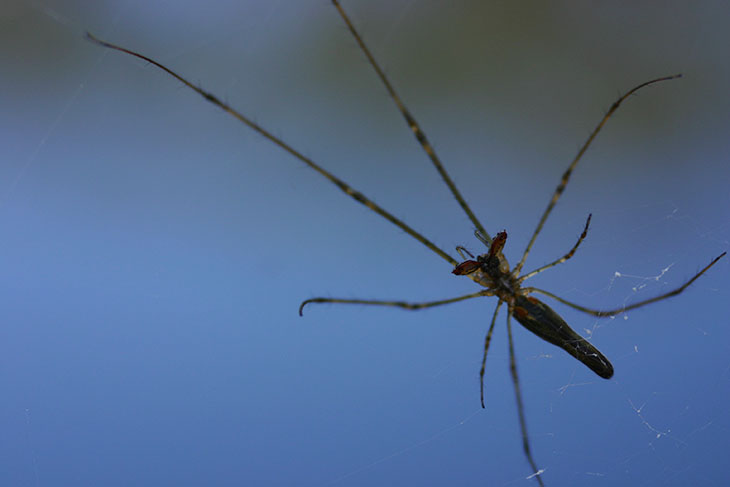

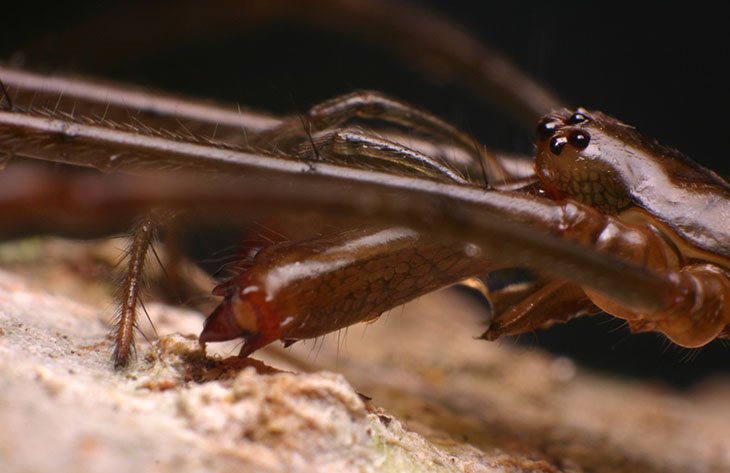
 Here’s a better look at those chelicerae, the best I managed – my model was shot in situ with only some nudges to try and achieve a better angle, so conditions were a bit limiting. They’re still sufficient to see that the chelicerae are these studded war clubs of appendages, two big cans of whupass with easy-open tops (no, I did not learn my writing style from Shakespeare or Dickens, why do you ask?) While I would like to offer some insight into why Tetragnathas require such huge canines, I’m afraid I’m at a total loss, since their food consists of flimsy slow water flies that certainly don’t seem hard to subdue – perhaps their venom is especially weak so they have to beat their prey to death. As you ponder this, take note of the coloration on the chelicerae and lower ‘face,’ in the image above, continuing the theme from the abdomen and indicating that the carpet does match the drapes (yeah, I’m in one of those moods.)
Here’s a better look at those chelicerae, the best I managed – my model was shot in situ with only some nudges to try and achieve a better angle, so conditions were a bit limiting. They’re still sufficient to see that the chelicerae are these studded war clubs of appendages, two big cans of whupass with easy-open tops (no, I did not learn my writing style from Shakespeare or Dickens, why do you ask?) While I would like to offer some insight into why Tetragnathas require such huge canines, I’m afraid I’m at a total loss, since their food consists of flimsy slow water flies that certainly don’t seem hard to subdue – perhaps their venom is especially weak so they have to beat their prey to death. As you ponder this, take note of the coloration on the chelicerae and lower ‘face,’ in the image above, continuing the theme from the abdomen and indicating that the carpet does match the drapes (yeah, I’m in one of those moods.)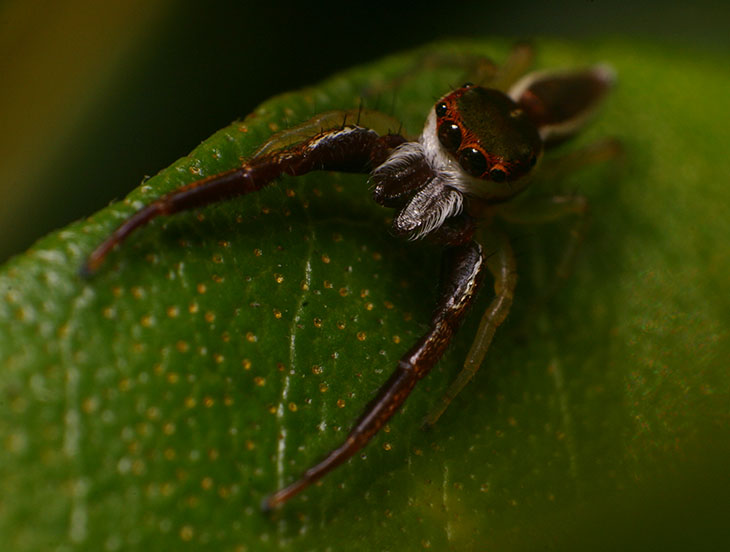
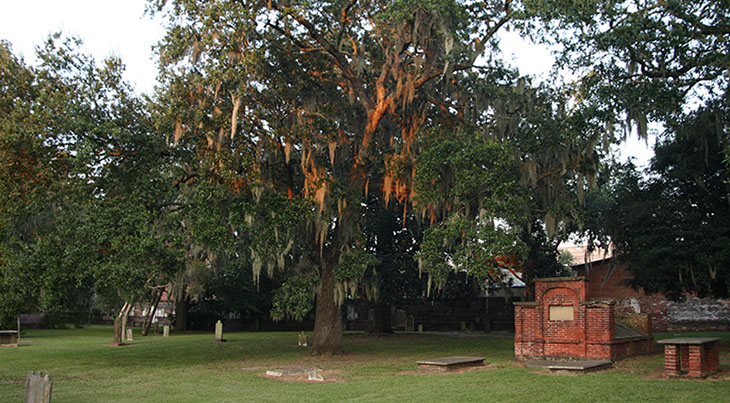




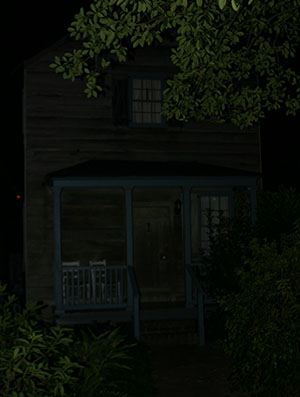 Eventually I met up with The Girlfriend and The Younger Sprog, who’d enjoyed the ghost tour – a different one than
Eventually I met up with The Girlfriend and The Younger Sprog, who’d enjoyed the ghost tour – a different one than 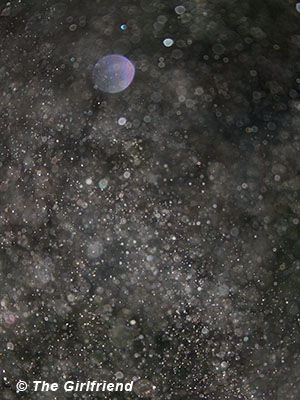 If you wanted proof that Savannah is the most haunted city in America, there you have it – the little spooks inhabit every grain of sand. I’m sure if you look hard enough you can find whatever kind of shape or face you want – I myself see an owl monkey, and a Tusken Raider (it’s subtle, but the joke is in there.) This is, of course, a simple optical effect, the flash’s light bouncing from reflective objects too close to be in focus, made more distinctive by a dark background – in optical terms, these are ‘circles of confusion.’ I’ve personally done it with mist, corn starch, soap bubbles, and now with glittery sand, and it’s more pronounced when the camera flash is very close to the lens (when the flash is further out, the sand/dust/whatever directly in front of the lens doesn’t get any light, since it passes above, and by the time they’re far enough away to be in the strobe beam, they’re in focus enough to be a tiny speck that’s usually ignored.) Focusing further out helps the effect, too, since close objects are further out of focus. Those that captured orbs on the tour might have caught dust, humidity, and possibly even something the guide provided. So yeah, “atmosphere…”
If you wanted proof that Savannah is the most haunted city in America, there you have it – the little spooks inhabit every grain of sand. I’m sure if you look hard enough you can find whatever kind of shape or face you want – I myself see an owl monkey, and a Tusken Raider (it’s subtle, but the joke is in there.) This is, of course, a simple optical effect, the flash’s light bouncing from reflective objects too close to be in focus, made more distinctive by a dark background – in optical terms, these are ‘circles of confusion.’ I’ve personally done it with mist, corn starch, soap bubbles, and now with glittery sand, and it’s more pronounced when the camera flash is very close to the lens (when the flash is further out, the sand/dust/whatever directly in front of the lens doesn’t get any light, since it passes above, and by the time they’re far enough away to be in the strobe beam, they’re in focus enough to be a tiny speck that’s usually ignored.) Focusing further out helps the effect, too, since close objects are further out of focus. Those that captured orbs on the tour might have caught dust, humidity, and possibly even something the guide provided. So yeah, “atmosphere…”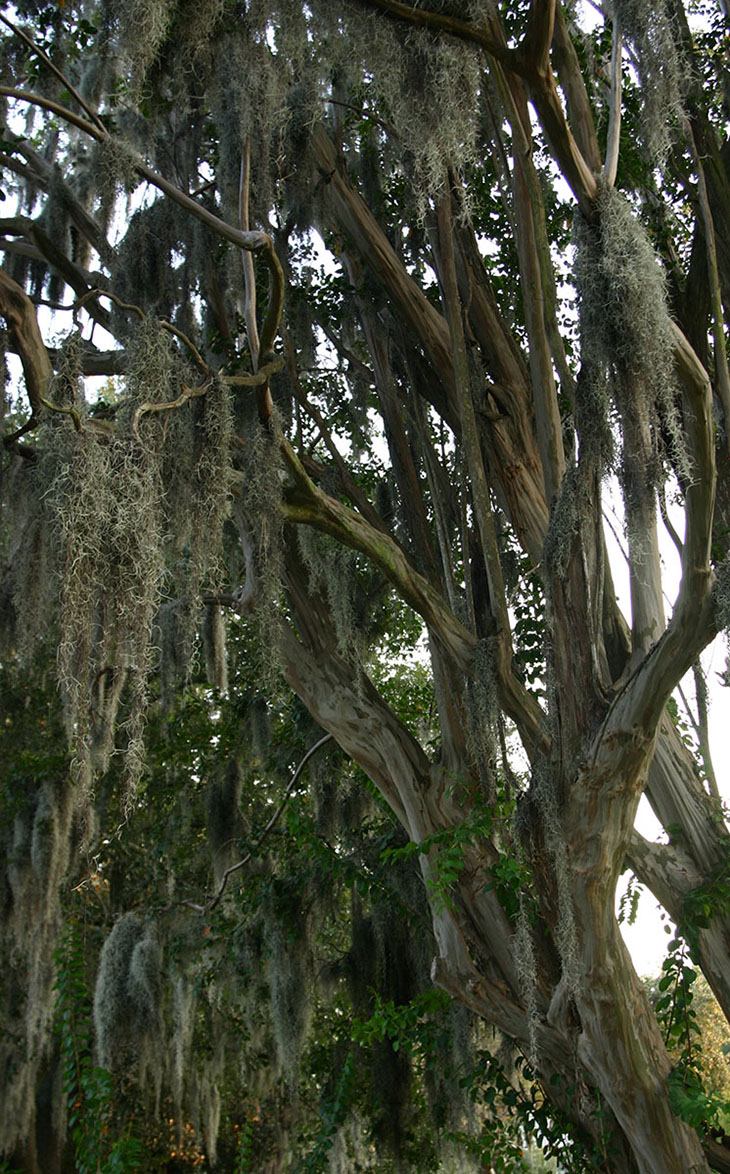
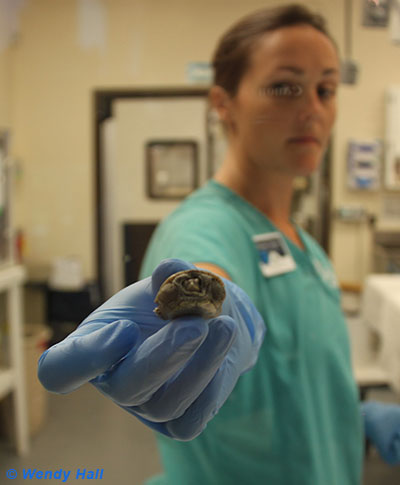

 Places like the Georgia Sea Turtle Center also rehabilitate turtles injured by fishing gear, boat propellers, shark attacks, parasitic infestations, and even ingesting those ubiquitous goddamned plastic bags (which they mistake for jellyfish.)
Places like the Georgia Sea Turtle Center also rehabilitate turtles injured by fishing gear, boat propellers, shark attacks, parasitic infestations, and even ingesting those ubiquitous goddamned plastic bags (which they mistake for jellyfish.) 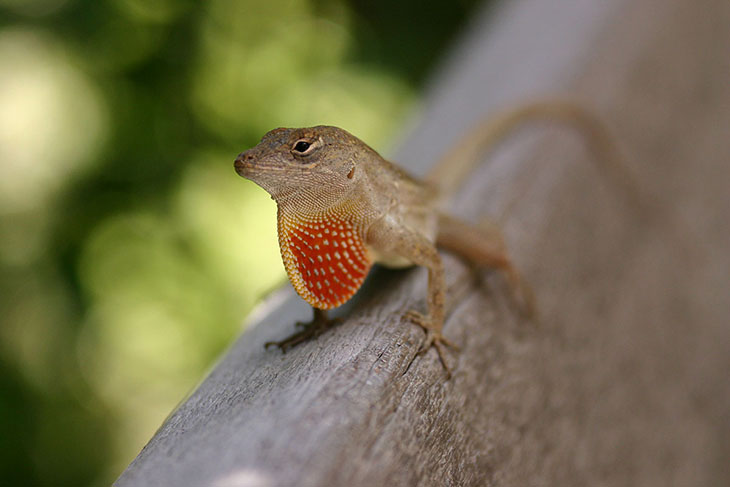
 We headed north a short ways to St Simon’s Island, visible across the inlet from Jekyll, two of the many chunks of land separating the sea from the coastal wetlands that usually get the name “barrier islands.” There, we monkeyed around (seriously – I’m not showing you those pics) on a huge twisted old tree under the lighthouse, did a few portraits, and went for a swim in the inlet. I got some practice on my “block all the ugly unwanted details with foreground elements and cropping” techniques – the area surrounding the lighthouse was loaded with cars and signs – and I looked, once again in vain, for a decent place to do some snorkel explorations. We did the obligatory walk around the touristy areas of St Simon’s before heading back to Our Hosts’ Place outside of Savannah. Now, I probably could have amused myself for the week without leaving the property there, since they had a nearby pond with a lovely cypress swamp area, a beehive, and even some visitors (by now, you should know I’m not referring to humans with that.) They also had a Gator utility tractor that their dogs adored riding in, which we used for some exploring. The pond, alas, was too small to make an airboat viable – no southern swamps are complete without airboats.
We headed north a short ways to St Simon’s Island, visible across the inlet from Jekyll, two of the many chunks of land separating the sea from the coastal wetlands that usually get the name “barrier islands.” There, we monkeyed around (seriously – I’m not showing you those pics) on a huge twisted old tree under the lighthouse, did a few portraits, and went for a swim in the inlet. I got some practice on my “block all the ugly unwanted details with foreground elements and cropping” techniques – the area surrounding the lighthouse was loaded with cars and signs – and I looked, once again in vain, for a decent place to do some snorkel explorations. We did the obligatory walk around the touristy areas of St Simon’s before heading back to Our Hosts’ Place outside of Savannah. Now, I probably could have amused myself for the week without leaving the property there, since they had a nearby pond with a lovely cypress swamp area, a beehive, and even some visitors (by now, you should know I’m not referring to humans with that.) They also had a Gator utility tractor that their dogs adored riding in, which we used for some exploring. The pond, alas, was too small to make an airboat viable – no southern swamps are complete without airboats.


 The Girlfriend’s Younger Sprog had never seen an American alligator (Alligator mississippiensis) except in zoos, and that certainly doesn’t count, so we had to ensure that she saw one in the wild, and the Savannah National Wildlife Refuge is a pretty sure bet. Naturally, she had to show us all up by being the first to spot one, and the largest one at that – she had a rotten vantage point in the back seat on the grassland side of the drive instead of looking over the channel, and still found a beaut. Unfortunately, the height of the grass and decorum over approaching one weighing well over 90 kg (200 lbs) meant we have no really snazzy pics of that one, so what you see here is my meager find, whose head is as long as my blistered foot – just a leetle guy (it must be a male, since Our Female Host kept informing us that he was a Good Boy.) If you look close you can see minnows sharing the water alongside.
The Girlfriend’s Younger Sprog had never seen an American alligator (Alligator mississippiensis) except in zoos, and that certainly doesn’t count, so we had to ensure that she saw one in the wild, and the Savannah National Wildlife Refuge is a pretty sure bet. Naturally, she had to show us all up by being the first to spot one, and the largest one at that – she had a rotten vantage point in the back seat on the grassland side of the drive instead of looking over the channel, and still found a beaut. Unfortunately, the height of the grass and decorum over approaching one weighing well over 90 kg (200 lbs) meant we have no really snazzy pics of that one, so what you see here is my meager find, whose head is as long as my blistered foot – just a leetle guy (it must be a male, since Our Female Host kept informing us that he was a Good Boy.) If you look close you can see minnows sharing the water alongside.
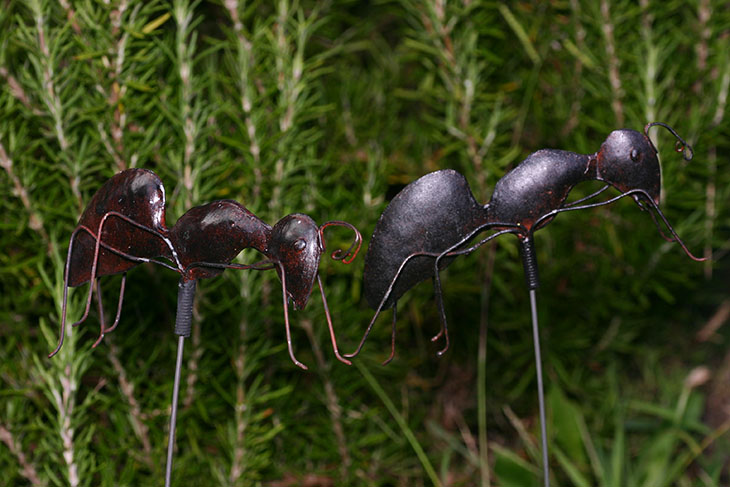
 And so, slowly, I return to posting, revealing in the process that the last three posts were scheduled ahead of time to appear when they did, since we just spent a scant week in Savannah, Georgia with friends. We fit in most of what we’d aimed for; the primary exception, for me, was being unable to find any scorpions, something I’ve been longing to photograph for a while, and additionally motivated by the recent purchase of an ultra-violet flashlight. Scorpions fluoresce under UV,
And so, slowly, I return to posting, revealing in the process that the last three posts were scheduled ahead of time to appear when they did, since we just spent a scant week in Savannah, Georgia with friends. We fit in most of what we’d aimed for; the primary exception, for me, was being unable to find any scorpions, something I’ve been longing to photograph for a while, and additionally motivated by the recent purchase of an ultra-violet flashlight. Scorpions fluoresce under UV, 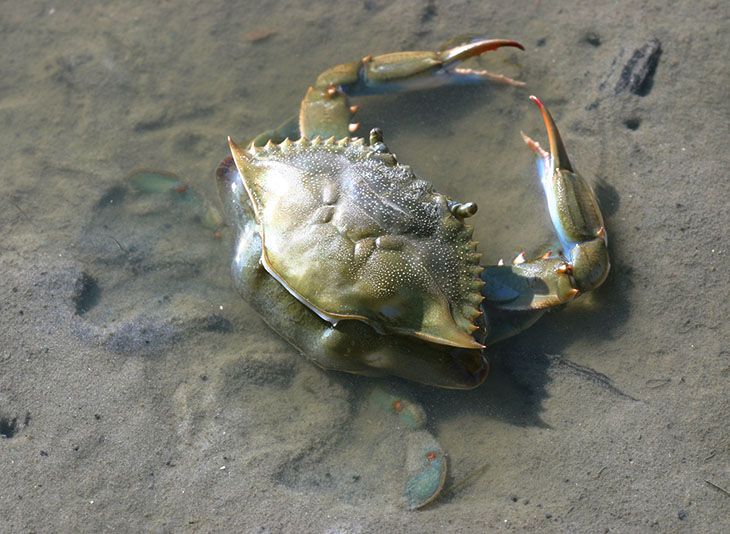
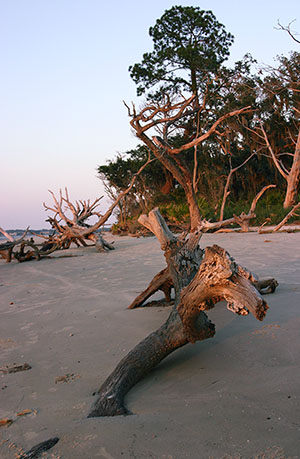 Now, there are two things that negatively affect sunset photography. The first, rather obviously, is overcast or stormy conditions. But the second is the polar opposite – skies that are too clear produce weak colors and no interesting cloud lighting or moody backgrounds. And unfortunately, the latter was what we had for our evening on Jekyll. While the light from the setting sun will go amber at least, seen here and in the opening image, to get the deep reds and purples that make for the groovy landscape shots takes significant humidity, and that just wasn’t present. I’ve said it before: nature photography takes a bit of luck in getting the right conditions – the skill part is knowing how to use them and being in the right place when they appear.
Now, there are two things that negatively affect sunset photography. The first, rather obviously, is overcast or stormy conditions. But the second is the polar opposite – skies that are too clear produce weak colors and no interesting cloud lighting or moody backgrounds. And unfortunately, the latter was what we had for our evening on Jekyll. While the light from the setting sun will go amber at least, seen here and in the opening image, to get the deep reds and purples that make for the groovy landscape shots takes significant humidity, and that just wasn’t present. I’ve said it before: nature photography takes a bit of luck in getting the right conditions – the skill part is knowing how to use them and being in the right place when they appear.  Perhaps the most-asked question from my photo students is about getting decent sunset images, because it’s actually a bit tricky. The camera’s exposure meter aims to produce
Perhaps the most-asked question from my photo students is about getting decent sunset images, because it’s actually a bit tricky. The camera’s exposure meter aims to produce  And then, I made a small mistake: I let Our Hosts book our suite without asking them where, exactly, we were staying. There wasn’t anything wrong in the slightest with our room – quite the contrary – but it meant I made no plans to be up at sunrise to chase more images, unaware that we were a short walk from the east shore of the island and ideally positioned for such pursuits. I woke early anyway, but didn’t venture out until the sky was fully light, to discover the beach so close. It meant that the light was much fiercer than preferred (again, pretty clear conditions,) but I still chased a few images anyway, joined a little later on by The Girlfriend and Our Female Host. There was some delay caused by camera lenses that had been sitting in air-conditioning overnight and were thus cool enough to attract condensation from the warm sea air, requiring several minutes to warm up and get clear. While you can wipe condensation away, it’ll return immediately until the glass temperature is right, and for dog’s sake don’t switch lenses in these conditions; condensation on inner surfaces, especially in a zoom or on the camera mirror, can take forever to clear. But while waiting, I used the fog as a soft-focus effect and tried a few shots anyway, with halfway-decent results. I admit to tweaking contrast slightly higher for the image at right.
And then, I made a small mistake: I let Our Hosts book our suite without asking them where, exactly, we were staying. There wasn’t anything wrong in the slightest with our room – quite the contrary – but it meant I made no plans to be up at sunrise to chase more images, unaware that we were a short walk from the east shore of the island and ideally positioned for such pursuits. I woke early anyway, but didn’t venture out until the sky was fully light, to discover the beach so close. It meant that the light was much fiercer than preferred (again, pretty clear conditions,) but I still chased a few images anyway, joined a little later on by The Girlfriend and Our Female Host. There was some delay caused by camera lenses that had been sitting in air-conditioning overnight and were thus cool enough to attract condensation from the warm sea air, requiring several minutes to warm up and get clear. While you can wipe condensation away, it’ll return immediately until the glass temperature is right, and for dog’s sake don’t switch lenses in these conditions; condensation on inner surfaces, especially in a zoom or on the camera mirror, can take forever to clear. But while waiting, I used the fog as a soft-focus effect and tried a few shots anyway, with halfway-decent results. I admit to tweaking contrast slightly higher for the image at right.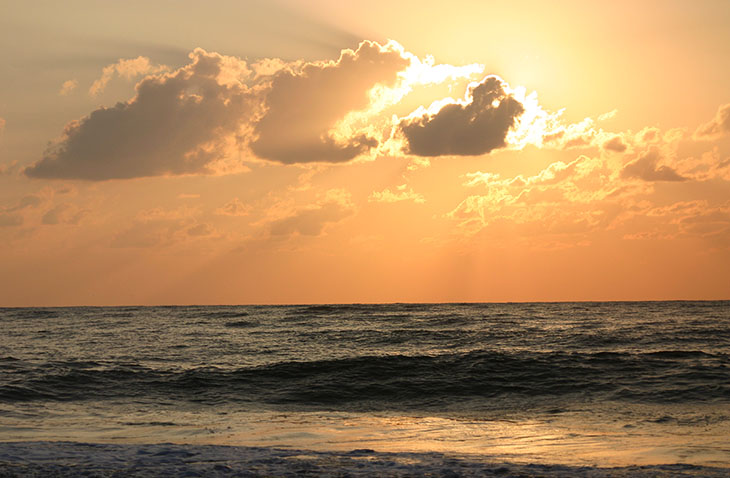

 And to the right, an inset of the same image, contrast enhanced slightly. While The Girlfriend and I were shooting down amongst the driftwood, it seems Our Hosts and The Girlfriend’s Younger Sprog were trying to attract our attention from the pier – you can just make our Our Female Host waving. I hadn’t the faintest idea they were there, being only millimeters tall in the wide-angle lens I was using, and only discovered this a few days later when they asked if we’d seen them and I happened to check the images closely. Sorry about that, guys – I would have framed you against the sun had I known.
And to the right, an inset of the same image, contrast enhanced slightly. While The Girlfriend and I were shooting down amongst the driftwood, it seems Our Hosts and The Girlfriend’s Younger Sprog were trying to attract our attention from the pier – you can just make our Our Female Host waving. I hadn’t the faintest idea they were there, being only millimeters tall in the wide-angle lens I was using, and only discovered this a few days later when they asked if we’d seen them and I happened to check the images closely. Sorry about that, guys – I would have framed you against the sun had I known.

